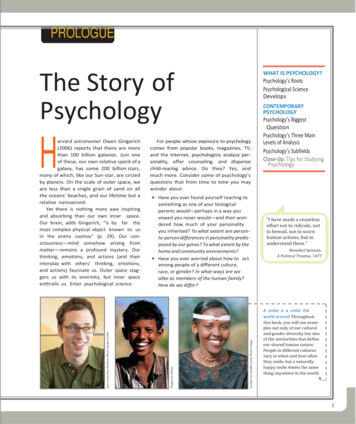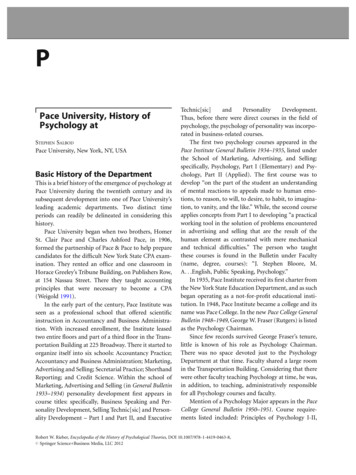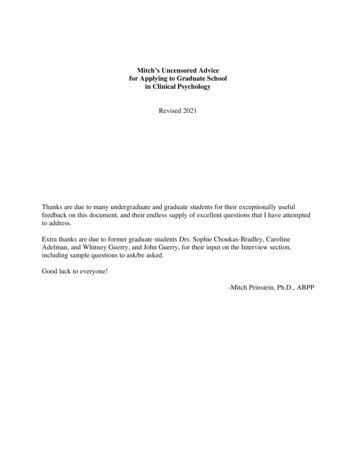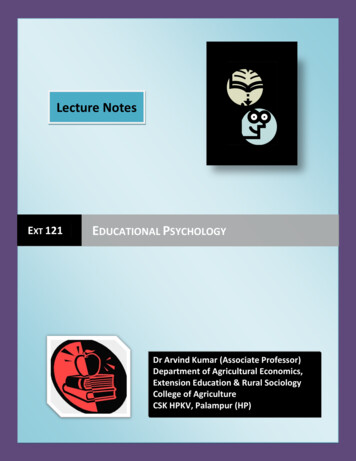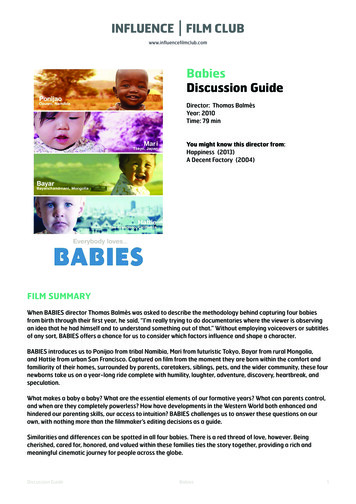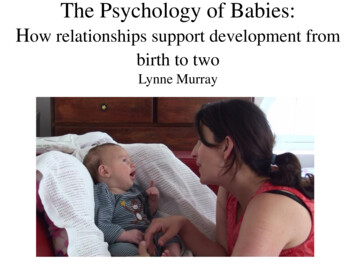
Transcription
The Psychology of Babies:How relationships support development frombirth to twoLynne Murray
Influences on development Child’s own characteristics- e.g., temperament(especially relevant to emotion regulation and selfcontrol) Continuing environmentNonethelessEarly experience can either directly affectdevelopment (e.g. language learning) orset the child on a pathway, which thenaffects how child engages with otherpeople and the wider world
Early development, when infants are helpless, unfoldsin the context of social relationships –the ‘Socialbrain’Relationships support development in Four keypsychological domainssocial-understand others, share and cooperate;attachment-feel secure and resilient;emotion regulation- manage difficult feelings andlearn self-control;cognitive-develop skills, language, reasoning
In each of these four domains,development by age two-three yearspredicts later child (and sometimes evenadult) functioning.e.g., Social understanding by two yearspredicts ‘Theory of mind’ skills andsocial competence in later childhood(Thoermer et al., 2012)
Attachment in infancy predicts quality ofintimate relationships (Groh et al., 2014) andexperience of depression in adolescence (Murray etal., 2011). Aggression that is pervasive and persistent attwo-three years predicts violence andaggression in adolescence (Tremblay et al., 2005) Cognition (memory/attention/IQ) in infancypredicts academic achievement at 16 and 21years (Fagan et al., 2007; Murray et al., 2010; Bornstein, 2012)
‘Specificity of effects’Each domain of child psychologicaldevelopment involves a different kind ofsupport from the baby’s carers.This has important implications for interventions
1. Support for social understanding‘Mirroring’, orimitation gamessupport ‘core relatedness’‘Ostensive marking’helps share connectionto the world
Support for social understanding Engaging in teasingbaby plays withothers’ mental experiences
Support for social understanding Pretend playImagining others’mental experiences Talking about feelings
2. Support for attachment securityAttachment needs are active when the baby feelsvulnerable-e.g., tired; ill, frightened, aloneBabies develop attachments to the key peoplewho care for them- e.g., parents, grandparents, professionalsFeel ‘secure’ when attachment needs are met-i.e.when carer responds, supports and understandsBeing securely attached doesn’t mean being‘overly dependent’
Classic signs of attachment Separation anxiety Stranger fear During separation and reunion in an unfamiliarenvironment
Signs of attachment- separation anxiety7 months
Signs of attachment- stranger fear8-11months
Signs of secure attachment- inseparation and reunion 18 months
3. Support for emotion regulation andcontrol
Support for emotion regulation andcontrol Mismatch repairBody gamesPlay fightingDealing with conflictsRoutinesReasoning and discussionEncouraging helpfulness
Interactions are NOT perfect- frequent‘mismatches’
Repairing mismatches supportslearning to cope
Body games: extend tolerance and regulatory abilities
Practising risky emotions
Play, or ‘mock’ fighting, supportseffortful control
Handling frustration: Routine gives senseof predictability, and therefore control
Managing conflict-flexibility, warmth
consistency
Harnessing impulse to join inencourages cooperation
Explaining and negotiating- about spitting
An amicable truce
4. Cognitive development‘Cognitive’ includes Attending Reasoning Learning Language And, in babies, actions and motor skills
Learning from action experience
Support through relationships ContingencyAttention regulationFacilitation and scaffoldingTalking and book sharing
Contingency: the Double VideoExperiment (Murray & Trevarthen, 1985)Speaker playing mother’svoiceBabywatchingmum on TVmonitorCamera filmingbabySpeaker playing baby’s voiceMonitormum’sfaceMonitorbaby’sfaceCamera filmingmotherMumwatchingbaby on TVmonitor
Contingency Disruption-Double VideoExperiment: Live sequenceIris watches her mother who is contingently responding to her behaviour
Contingency Disruption- DoubleVideo experiment: ReplayIris watches her mother who is not contingently responsive to her behaviour
Infant behaviour in live, replay and liveconditions of double videoSmiling76543210LiveMurray & Trevarthen, 1985ReplayLive2
Helping sustain attention
‘Scaffolding’ new skills
Book sharingYoung babies liketo exploreOlder babies canlearn words
Book sharingMaking links tothe babyhelps the learningprocess
Conclusions 1 Wider background- e.g., economic, regulationof day care and parental leave, mental state-allaffect parental (and professionals’) care. In turn, that care influences infantdevelopment. Know from many longitudinal studies of avariety of populations what the key parentingfactors are.
Conclusions 2 Growing evidence base that specific parentingqualities support different domains of children’sdevelopment. These change as the infant develops Understanding these developmental processesenables us to target interventions in a more focusedway, so as to maximize their benefits
The Psychology of Babies: How relationships support development from birth to two Lynne Murray . Influences on development Child’s own characteristics- e.g., temperament (especially relevant to emotion regulat



